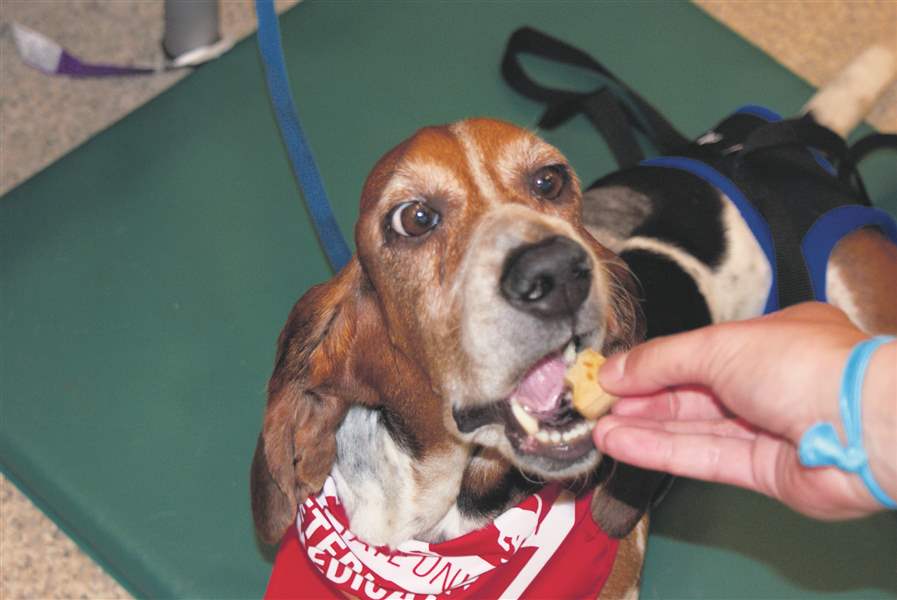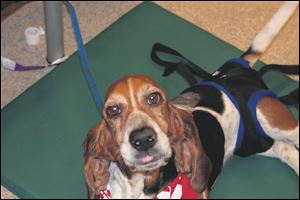
Z-Girl is back: Veterinary medicine offers hope, relief to pets and their owners
9/28/2013
Zoe is rewarded with a dog biscuit for being a good patient.

Zoe rests after surgery.
COLUMBUS — Dr. Bianca Hettlich has such a soothing way of putting a concerned pet owner at ease that I told her she should practice medicine on people — and that was before she operated at Ohio State University’s Veterinary Hospital on my basset hound Zoe to repair a ruptured disk.
With no possibility of such a surgery being performed in Toledo, last spring my Zoe, 6, spent four days at OSU’s hospital for companion animals. She was paralyzed because of intervertebral disk disease and could only drag her hind legs and feet. It was so tough to watch that it brought tears to my eyes, but I learned that vet medicine offers hope to pet owners and relief to the animals.
Since the summer trips to OSU, Zoe is mostly back to herself, getting into things, sashaying through the house, scampering with her canine playmate, barking loudly, and being cuddly and regal.
Our journey to get Zoe back to health was time-consuming, but worth it. She couldn’t say what hurt, so I had to try to figure that out. I was distraught and blamed myself, as she was clearly miserable. She was getting me up hourly at night to go out. Reflecting now, I think she was uncomfortable at night and simply wanted attention more than anything. To my relief, Dr. Hettlich said neither I nor Zoe was to blame.
The ruptured disk was clear on the CT scan; amazingly, animals get those tests, too. After all, the vet hospital on Vernon L. Tharp Street in Columbus was much like a medical facility for people.
As numerous owners and their pets waited to be seen, many students, residents, professors, and doctors scurried about in blue and white coats, displaying their respect for animals, celebrating with owners when outcomes called for it, offering them hope where they could, and empathizing where they couldn’t. A well-staffed and courteous front desk checked people in and out.
“It’s nothing you did and it’s nothing she did,” said Dr. Hettlich. She was hopeful that Zoe would make a full recovery. Back injuries are common in her breed and in other long-back dogs.
“Dachshunds, beagles, bassets, miniature poodles, etc. — essentially all miniature/toy breeds and most dogs with short legs and funny snouts are in a group of dogs call ‘chondrodystrophic,’” she explained in an email. “These dogs have a much higher incidence of disk related problems than other dogs, so when Zoe came to us, a ruptured disk was definitely very high on our differential list.”
As a puppy, Zoe had hip dysplasia, which bassets are prone to suffering. At several months old, she practically stopped moving around. Not a good sign for a new puppy, and we worried just as parents do when illness slows a rambunctious child. There were numerous trips to vets, much medication, and talk of surgery. Then Z or Z-Girl, as I call her, seemed to suddenly improve on her own, and she was back to her same royal self.
From then until this spring, weaved in with fun and entertaining times were a series of trips to the vet to tend to her allergies and skin problems and pet stores to find the best, affordable food. In May, though, Zoe appeared to be in pain and even walked backwards a few times. Though she usually took her time to come when called, this was different, and it was scary.
Next were more visits to the vet, who said we faced putting her down or costly surgery. The vet said to think about it during the weekend. I did. I prayed for a solution and cried because I felt I was preparing to say good-bye to my stubby four-legged girlfriend. It was Memorial Day weekend, and a rapidly deteriorating condition required a holiday trip to a local animal emergency hospital, where she obtained temporary relief.
But then she began dragging her hind legs, completely unable to use them. I cordoned her off in one room and took her out to relieve herself, using a towel underneath her hind section to lift her body so she wouldn’t drag her feet and legs.
Meanwhile, my insight into veterinary medicine’s astonishing progress began to expand. I learned there was a remedy for Zoe’s ailment: a form of back surgery called hemilaminectomy. Dr. Hettlich said, “means that part of the roof of the spinal canal is removed to allow access into the canal to then remove ruptured disk material.”
Dr. Hettlich is assistant professor of veterinary clinical sciences and an orthopedic surgeon who also does neurosurgery at Ohio State University’s Veterinary Hospital in Columbus. OSU’s vet teaching hospital is one of 27 such facilities in North America, and it’s one of the largest in terms of caseload and ability to treat all species.
The nearest vet to Toledo that performs hemilaminectomy on canines is in Ann Arbor, according to veterinarians at the West Suburban Animal Clinic in Sylvania Township. Meanwhile, Dr. Hettlich said OSU’s vet hospital does from 50 to 100 spinal decompression surgeries a year, which cost from $2,500 to $5,000, with most at the lower end.

Zoe is rewarded with a dog biscuit for being a good patient.
The most common such surgery is the “hemilaminectomy of the middle of the back, which we also did on Zoe. Many of these will likely be dachshunds — definitely long-back dogs. We do not see too many bassets overall, which I believe is more due to not that many people owning bassets, but other dogs.”
When we arrived at OSU, Zoe was placed on a gurney; she was so pitiful and she couldn’t walk. Her deep pain response was good, which meant that her chance of recovery was strong, and Dr. Hettlich was “super optimistic.” While other tests ruled out such problems as stroke, intern Johnattan Arango cautioned, “she might never be completely normal again.”
During the next few days, twice a day I received progress reports. Senior student Shawna Houston called several times, reporting once that Zoe wagged her tail excitedly, banging it against the cage. I was familiar with that drum-stick-like banging, so I knew that was good. Not all animals that have a hemilaminectomy wag their tails right away. Then, when she whined, they looked to see whether she in pain or having separation anxiety. I knew it was the latter because she does not like to be alone. The staff let her sit with them as they went about business and she was happy, enjoying treats and belly rubs.
At checkout time, I learned how to give her therapy. For the next month at home, Zoe was kept confined in a comfortable dog crate except when she had to relieve herself and for therapy. I worked those short stubby legs, pulling, bending, and stretching as she would use them when she walked again. It would be a few weeks before she would be allowed to walk on her own, so when she went out, I helped her walk by using the handles on a Walkabout rear harness that she wore.
“Time is really of the essence for most dogs — Zoe was really, really lucky — and if people understand what goes on, they will hopefully seek help for their four-legged friends,” Dr. Hettlich said.
When I got Zoe as a puppy, the cuddly little thing promptly took to chewing and hiding my shoes. Sensing I was upset, she’d look at me with those big ol’ eyes and drop her long ears as if to say, “Sorry. Don’t be upset.” How could I remain annoyed?
Anymore, chewing shoes is “puppy stuff.” When she wants more attention now, she swishes her tail and plants a big paw on my foot, or stretches her short front leg, moving her paw as if she’s waving. I’m thankful she can do that again. I got my Z-Girl back, and I’m glad.
Contact Rose Russell at: rrussell@theblade.com or 419-724-6178.